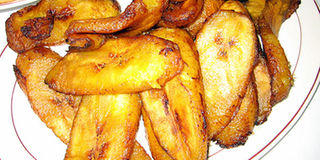All about that gonja recipe, storage

Gonja, deep fried, is a delicacy at parties. File photo
What you need to know:
The versatility of gonja is remarkable and with some creativity one can serve the vegetable as an appetiser, in soups and even desserts
Do it yourself. What you need to know about gonja and how to prepare it,writes A. Kadumukasa Kironde II.
If one were to serve a Muganda gonja in place of matooke, this would be an egregious mistake. Be that as it may, gonja is a firm and prominent member of the plantain family and, according to FAO figures of 2009, Uganda is the world’s largest producer of plantain harvesting an impressive 9.5 million metric tonnes followed by Ghana, Columbia, Rwanda and Nigeria.
Gonja can never be eaten raw and must be cooked before eating. They can be green yellow or very dark depending to the degree of ripeness.
In Uganda, the three most common forms of cooking gonja are three viz. fried, boiled or steamed and charcoal broiled. However, gonja can be served mashed though this is not often the case in Uganda. When it comes to the spicing up of gonja, Ghana is miles ahead of us. It is an unwritten cardinal rule in Uganda that gonja must be cooked au naturel and there is never any deviation from this norm.
The versatility of gonja is remarkable and with some creativity one can serve the vegetable as an appetiser, in soups and even desserts. In the past, gonja was unlikely to be found in restaurants; most people had to make do with buying it in the market and serving it from home. However, nowadays, places such as Café Javas make it a point to have it on the menu and you will be surprised how many people order gonja by the plate. Similarly, Mama Ashanti who specialises in West African fare serves a wickedly hot and spiced fried plantain in palm oil and kelewele peppers.
Preparing and storage
Gonja is commonly served year round with the most common form being the charcoal broiled which is easy for the women who cook by the roadside in the suburbs. This type of cooking requires little start up money; a sigiri with grill and some gonja and one is in business. Pricing is informal and at times you can get great bargains if the vendor has a lot in stock that is ripe. Unfortunately, rather like avocado, when you buy a bunch it tends to ripen the same time.
If you are preparing gonja at home, I find that the best way is to buy gonja that is ripe and ready to be used within a day or two. Buying a whole bunch can prove to be very costly and you may even end up with a lot of overly ripe gonja that may not have much appeal to the family.
Most local markets do not keep gonja in stock since it is fairly expensive and considered more of luxury than a staple such as matooke, cassava or sweet potatoes. However, Nakasero market always has gonja in abundance (both ripe and green) and though you will pay a high price, you are guaranteed that you will be able to buy it as and when you need it. One of my favourite and novel ways of preparing gonja is with sweet potatoes in the form of crisps. This is an easy to prepare recipe and you are bound to impress the family.
Gonja and Sweet Potato Crisps:
INGREDIENTS
Serves 4
2 unripe gonja plantains
1 small sweet potato
Red pepper flakes (optional)
Oil for deep frying
i. Using a small sharp knife, top and tail the gonja and cut in half. Make three or four slits lengthways along the natural ridge of the gonja and lift away the skin. Place the gonja in a bowl of cold salted water and set aside. The reason for the vegetables being soaked in cold water is to prevent discoloration.
ii.Peel the sweet potato and add to the bowl of salted water.
iii.Heat the oil in a large saucepan or deep fat fryer and while the oil is heating, remove the gonja and sweet potato and pat dry on kitchen paper.
iv.Slice the vegetables into thin rounds with a sharp knife or vegetable slicer.
v.Fry the gonja and sweet potatoes until crisp then drain and add the pepper flakes.
vi.Sprinkle with a little lo salt and serve when they have cooled.
These views are purely the reviewer’s personal reaction to food, ambience and service with price being factored into consideration. The menu listings are subject to change without notice.




